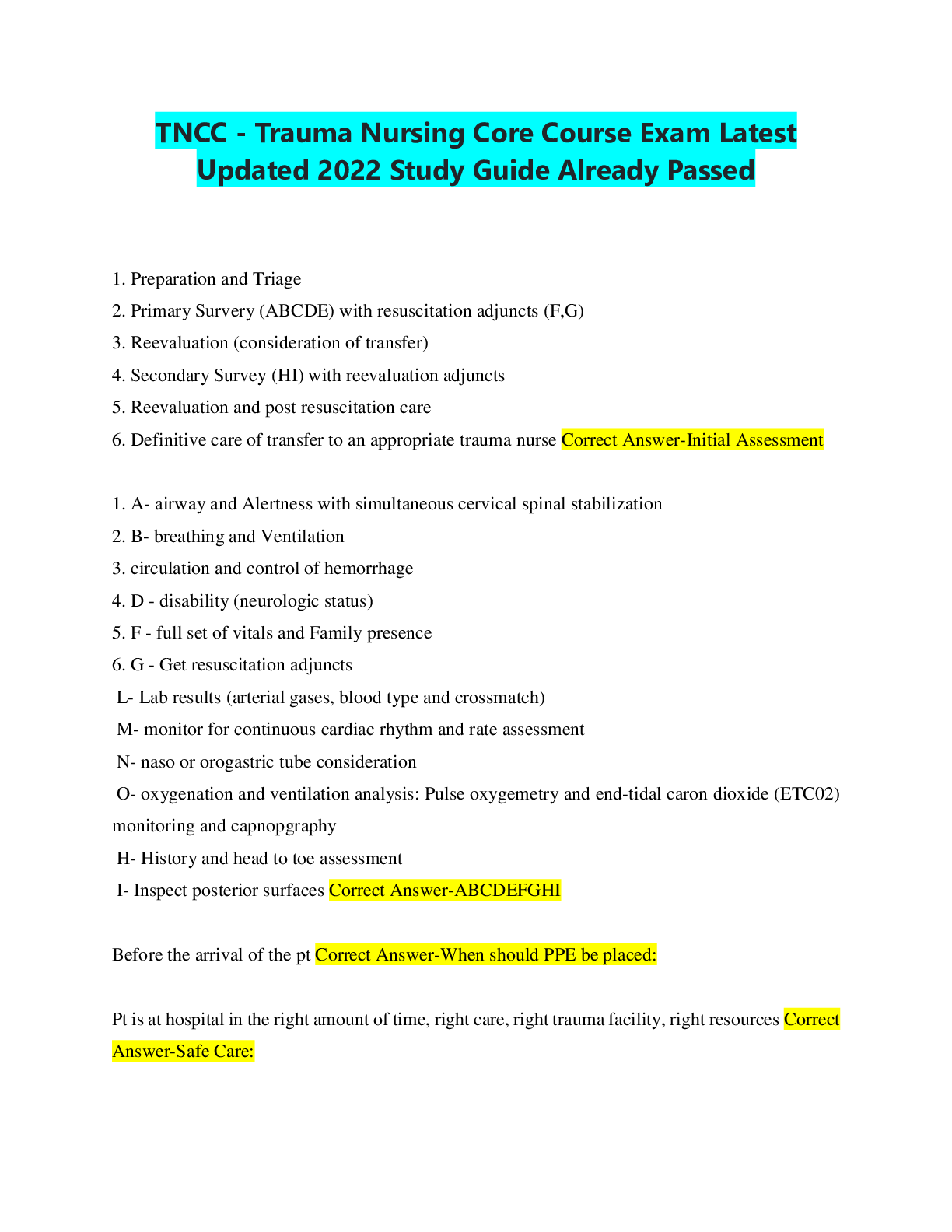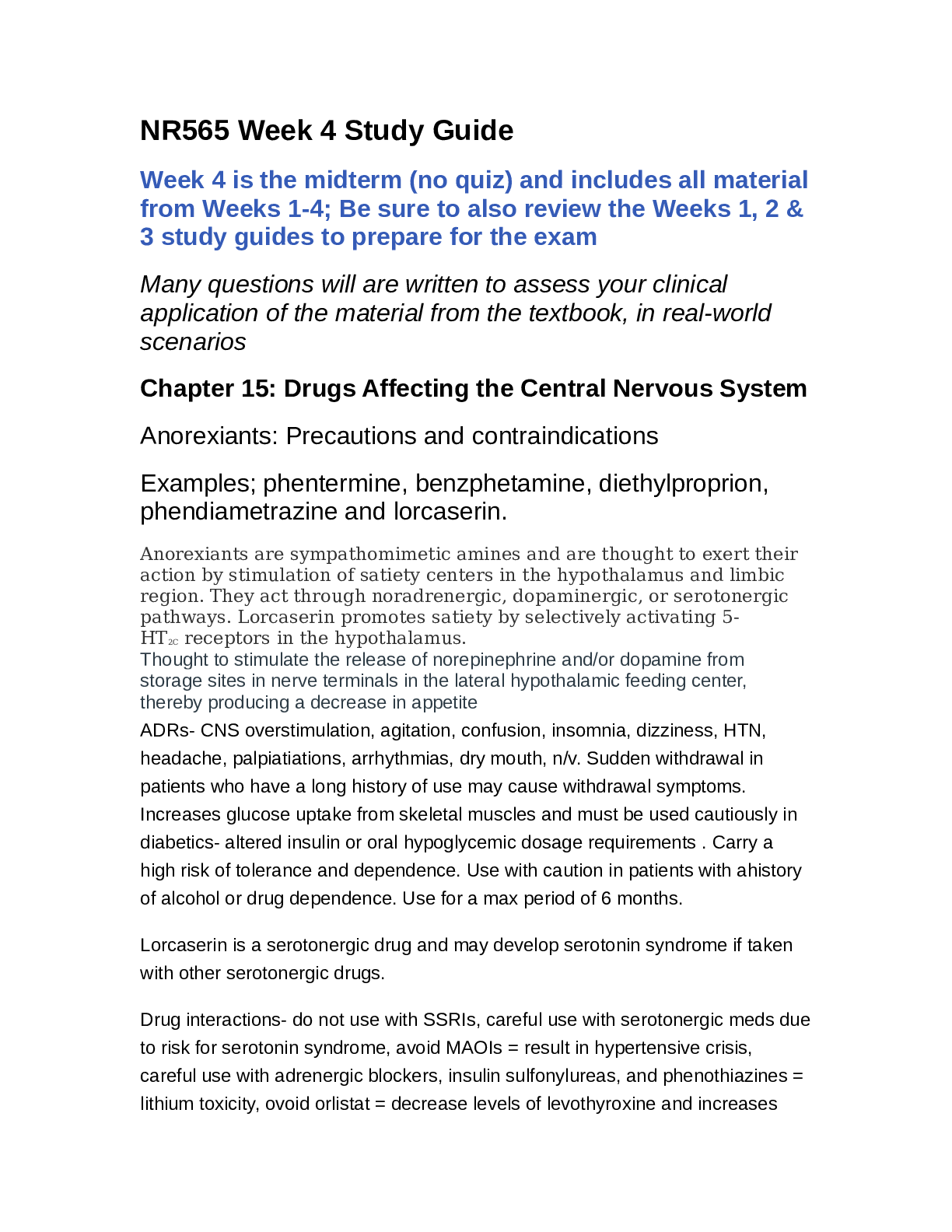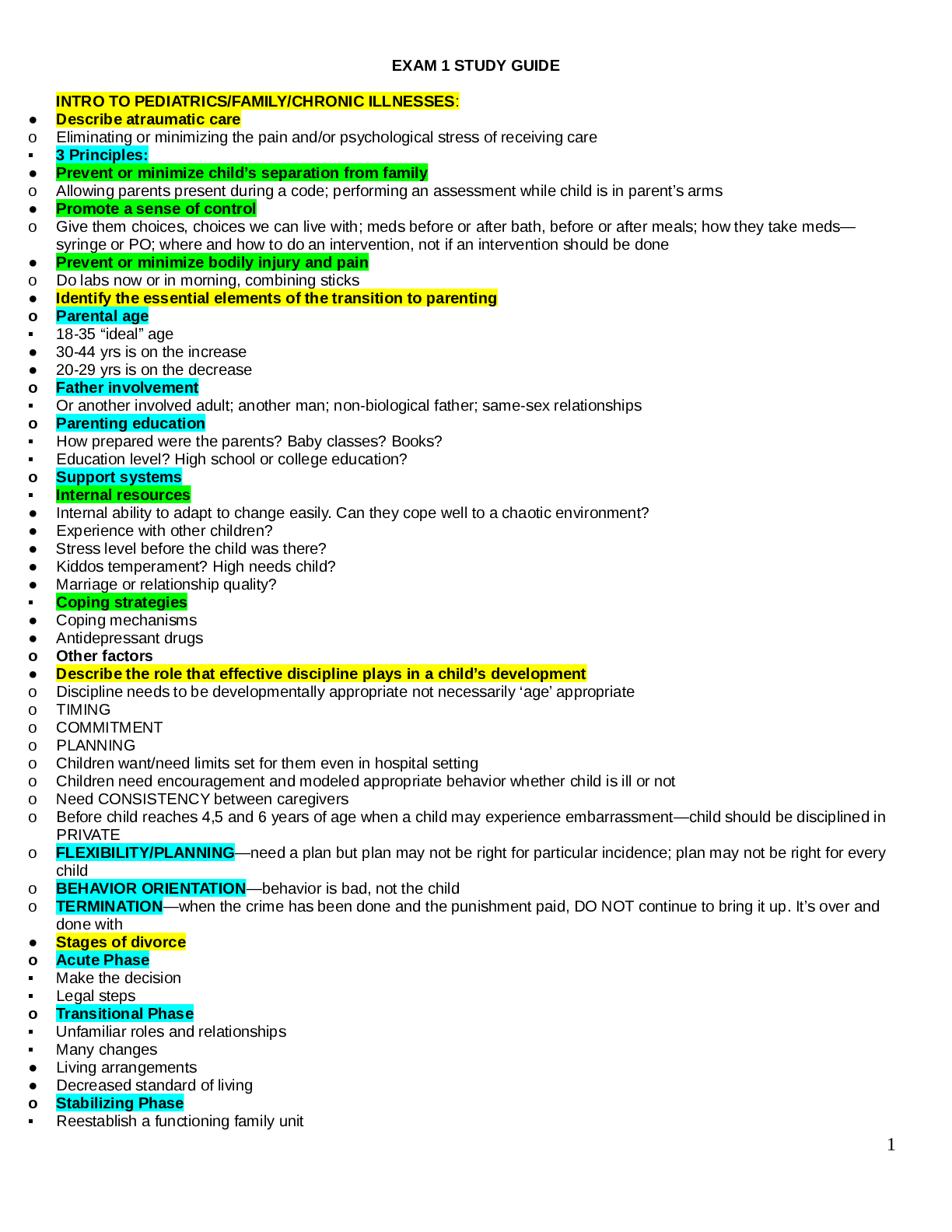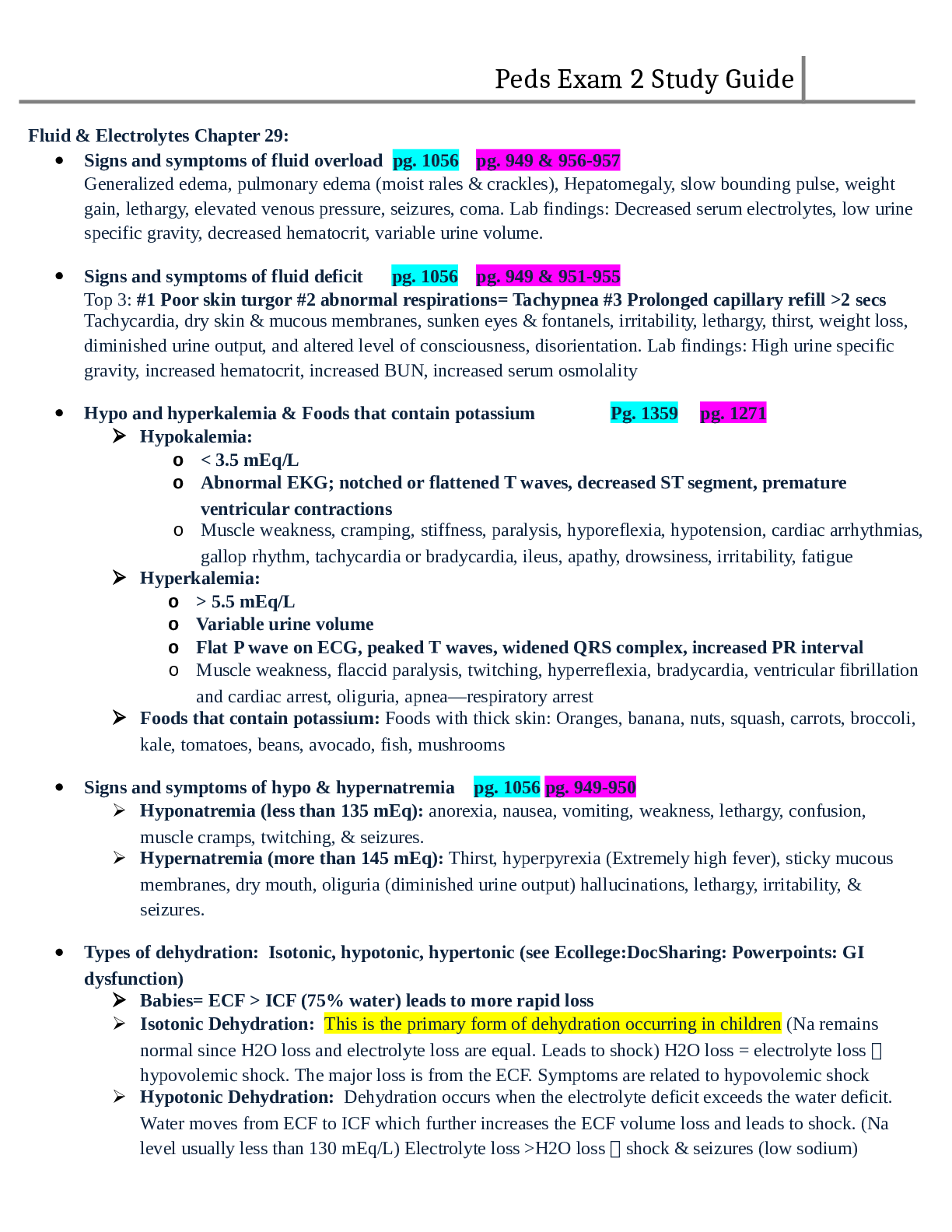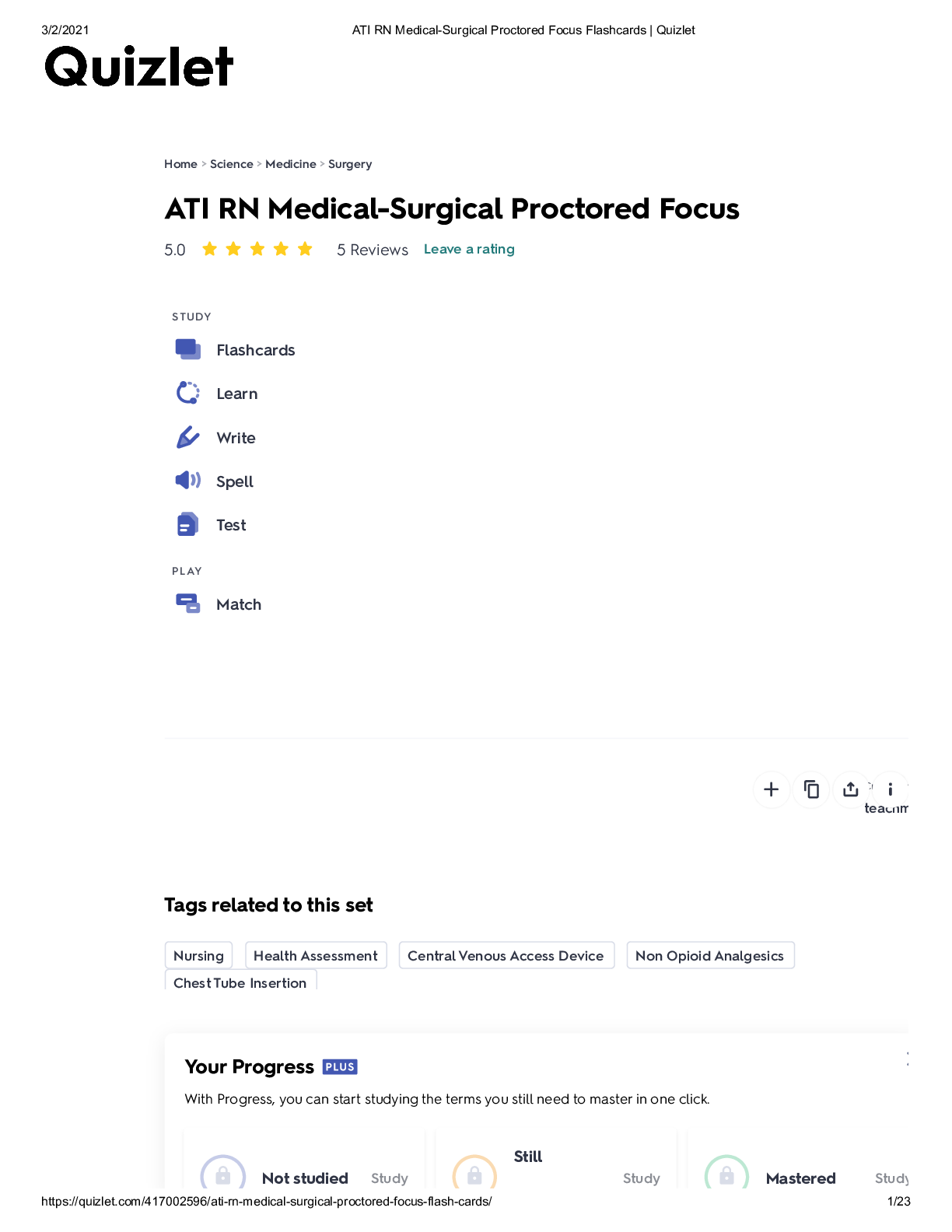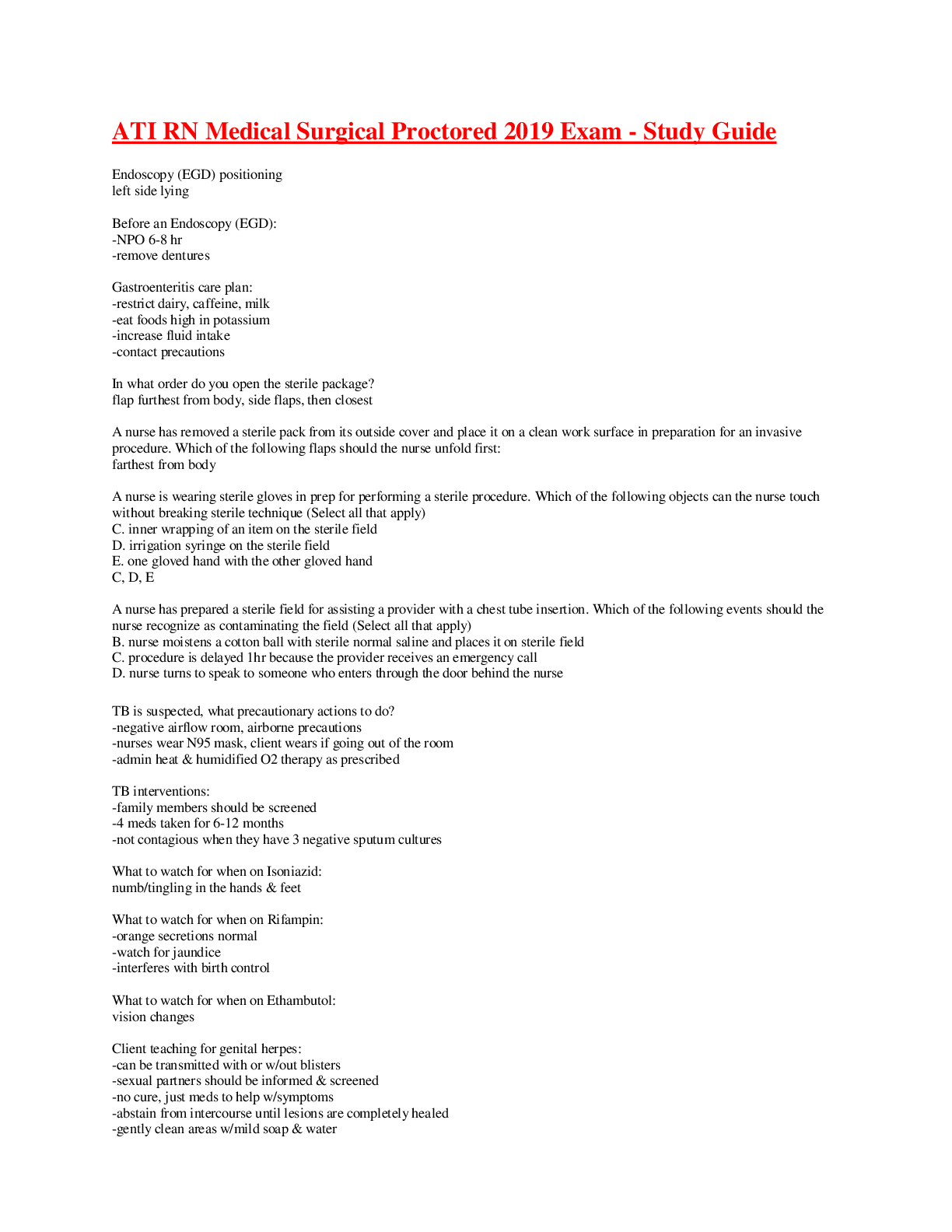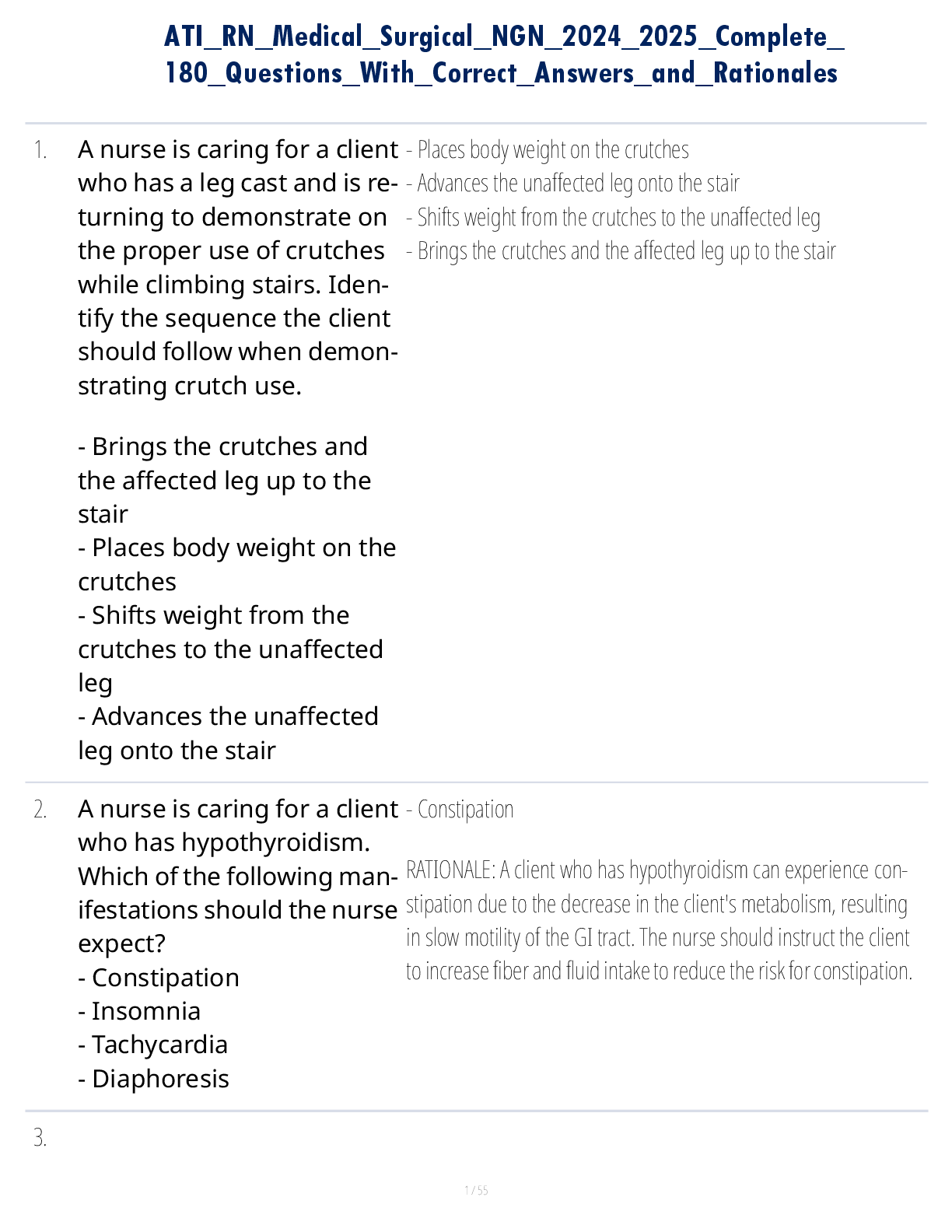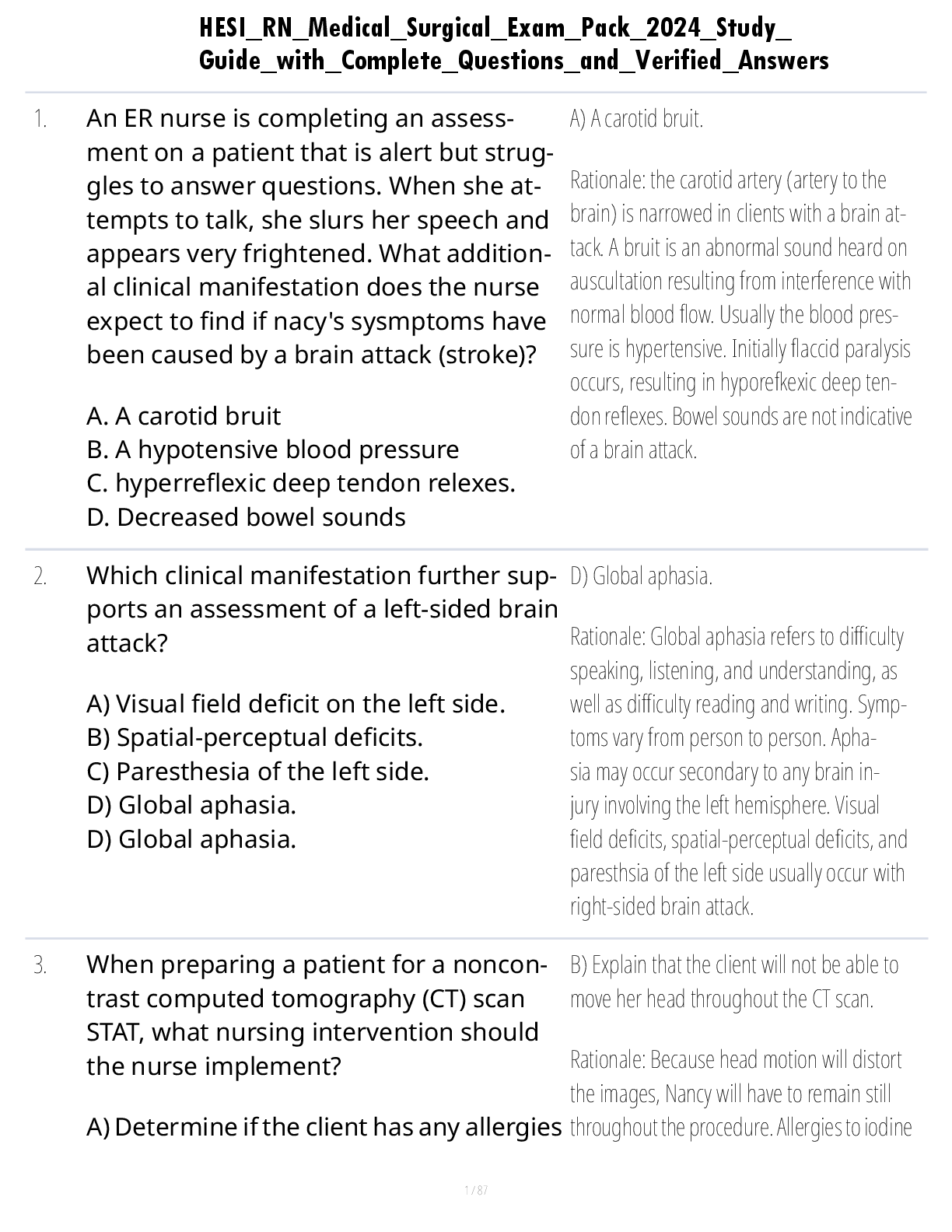*NURSING > STUDY GUIDE > Retake 2 RN Medical Surgical Nursing (All)
Retake 2 RN Medical Surgical Nursing
Document Content and Description Below
GI Diagnostics Procedure: Plan of Care for a Client Who Has Gastroenteritis (Ch.46) • A positive finding for clostridium difficile is indicative of this opportunistic infection, which usually becom... es established secondary to use of broad-spectrum antibiotics. • Medications: Some medications ( NSAIDs, warfarin, aspirin) place the client at risk for complications. Notify the provider if medication restrictions were not followed. • Blood Test: Interpretations of Findings o Aspartate aminotransferase/ Alanine Aminotransferase: Elevation occurs with hepatitis or cirrhosis. o Alkaline Phosphatase- Elevation indicates liver damage o Amylase/ Lipase- Elevation occurs with pancreatitis o Total Bilirubin- Elevation indicate altered liver function, bile duct obstruction, or other hepatobiliary disorder. o Albumin- Decrease can indicate hepatic disease. o Alpha-fetoprotein- Elevated in liver cancer, cirrhosis and hepatitis. o Ammonia- Elevated in liver disease. Tuberculosis: Appropriate Interventions for a Client Who Has Tuberculosis(Ch.23) • TB diagnosis should be considered for any client who has a persistent cough, chest pain, weakness, weight loss, anorexia, hemoptysis, dyspnea, fever, night sweats, or chills. • Mantoux Test o An intradermal injection of an extract of the tubercle bacillus is made. o A positive Mantoux test indicates that the client has developed an immune response to TB. o Individuals who have latent TB can retain positive MT test and can receive treatment. • Educate the client and family to continue medication therapy for its full duration of 6 to 12 months, even up to 2 years for multi-drug resistant TB. • Airborne precautions are NOT needed in the home setting because family members have already been exposed. Medical and Surgical Asepsis: Maintaining a Sterile Field ( Ch. 10) • The outer wrapping and 1-inch edge of packaging that contains sterile items are not sterile. • The inner surface of the sterile drape or kit, except for that 1-inch border around the edge the sterile field to which other sterile items may be added. • Consider any object held below the waist or above the chest contaminated. • Grasp the tip of the top flap of the package, and with arm positioned away from the sterile field, unfold the top flap away from the body. o Next, open the side flaps, using the right hand for the right flap and the left hand for the left flap. o Grasp the last flap and turn it down toward the body. Diagnostic and Therapeutic Procedures for Female Reproductive Disorders: Client Teaching about Genital Herpes ( Ch. 62) • Diagnosis of genital herpes can be based on the client history and physical. • Laboratory test o Herpes viral culture: fluid from a lesion is obtained using a swab and placed in a cup for culture. o Polymerase chain reaction: identifies genetic material of the virus. Cells from a lesion, blood, or other body fluids can be tested. o Antibody test: blood is tested for antibodies to the virus. ▪ HerpeSelect Immunoblot, HerpeSelect ELISA, Western Blot Postoperative Nursing Care : Preventing Complications (Ch.96) • Report a blood pressure difference of 25% from baseline, a drop to 15 to 20 mmH in diastolic or systolic pressures, or a trending decrease in diastolic or systolic pressures by 5 mmHg at each 15 minute sign assessment. • Extubating of endotracheal tube is based on client’s response to commands, ability to elevate head and use of thoracic breathing. • If the client responds to verbal stimuli, gradually elevate the head of the bed to semi-fowlers position, if not contraindicated, to facilitate chest expansion. Stroke: Caring for a Client Who has Left-sided Hemiplegia(Ch.15) • Left sided hemiplegia o Right extremity hemiplegia (paralysis) or hemiparesis (weakness) o Visual changes, such as hemianopsia (loss of visual field in one or both eyes). • Right sided hemiplegia o Unilateral neglect syndrome: ignore left side of the body: cannot see, feel or move affected side, so client unaware of its existence). Can occur when left hemispheric strokes, but is more common with right hemispheric strokes. o Left hemiplegia or hemiparesis o Poor impulse control and judgement Polycystic Kidney Disease, AKI and CKI: Dietary Recommendations for a Client who Has Nephrotic Syndrome (Ch. 59) • Restrict dietary sodium, potassium, phosphorous and magnesium. • Provide a diet that is high in carbohydrates and moderate in fat. • Restrict intake of fluids (based on urinary output). • Instruct the client to monitor the daily intake of carbohydrates, proteins, sodium, and potassium according to the providers prescription. • Instruct the client to avoid antacids containing magnesium. Antibiotics Affecting the Bacterial Cell Wall: Manifestations to Report to the Provider (Pharm Ch.44) o If indications of allergy appear (urticaria, rash, hypotension, dyspnea), stop the cephalosporin immediately, and notify the providers. o Monitor the infusion site for redness, swelling and inflammation. o Instruct clients to notify the provider if changes in hearing acuity develop. Nonopioid Analgesic: Medication Interactions (Ch. 35) • Acetaminophen o Acute toxicity : Results in liver damage with early manifestations of nausea, vomiting, diarrhea, sweating, and abdominal discomfort progressing to hepatic failure, coma and death • NSAID o Damage to gastric mucosa can lead to gastrointestinal (GI) bleeding and perforation, especially with long term use. o Observe for indications of GI bleeding (passage of black or dark colored stools, severe abdominal pain, nausea, vomiting). • Advise clients to notify providers if manifestations of salicylism occur. The medication should be discontinued until manifestations are resolved. The medication can be restarted at a lower dose. Blood and Blood Product Transfusions: Initiating a Transfusion of Packed RBC’s (Ch.40). • Prime the blood administration set with 0.9% sodium chloride only. Never add medications to blood products. Y-tubing with a filter is used to transfuse blood. • Initiate large bore IV access. An 18-20 gauge need is standard for administering blood products. • Acute Hemolytic Reaction o Findings include chills, fever, low back pain, tachycardia, flushing, hypotension, chest tightening or pain, tachypnea, nausea, anxiety, hemoglobinuria, and an impending sense of doom. Cardiovascular Diagnostics and Therapeutic Procedures: Flushing and Implanted Port (Ch.27) • Apply topical anesthetic cream to skin if indicated. • Palpate skin to locate the port body septum to ensure proper insertion of the needle. • Access with a noncoring (Huber) needle • Check for blood return prior to medication administration to confirm patency and placement. • Flush with 5 mL Heparin 100 units/ml after every use and at least once per month (NS Recommendation) Hematological Diagnostics Procedures: Evaluating Client Understanding of Anticoagulant Therapy ( Ch. 39). • Platelets : 150,000-400,000 mm o Increased: malignancy, polycythemia vera and rheumatoid arthritis o Decreased: enlarged spleen, hemorrhage, leukemia • WBC: 5,000-10,000 o Elevated: Infection or inflammation o Decreased: Immunosuppression, autoimmune disease • RBC: Females ( 4.2-5.4) Males ( 4.7-6.1) o Elevated: Erythocytosis, polycythemia vera, severe dehydration o Decreased: Anemia, hemorrhage, kidney disease TB: Teaching About Medication Therapy ( Ch.23) • Broad Spectrum Antimycobacterial –Rifampin o Three negative sputum culture for TB usually taking 3-6 months to achieve o Inform client regarding manifestations of anorexia, fatigue, and malaise and instruct them to notify the provider if they occur. o Educate the client and family to continue medication therapy for its full duration of 6 to 12 months, even up to 2 years for multidrug resistant TB. Emphasize that failure to take the medications can lead to a resistant strain to TB. Gastrointestinal therapeutic procedures: calculating protein requirements ( Ch. 47) • Never abruptly stop TPN. Speeding up/slowing down the rate is contraindicated. An abrupt rate change can alter blood glucose levels significantly. • Do not use TPN line for other IV bolus fluids and medications (repeated access increases the risk for infection). • If the stoma appears black, or purple in color, this indicates a serious impairment of blood flow and requires immediate intervention. Electrocardiography and dysrhythmia monitoring: analyzing a cardiac rhythm strip (Ch. 28) • Dysrhythmias are classified by the following: site of organ : SA node, atria, AV node or ventricle. o Effect on the rate and rhythm of the heart: bradycardia, tachycardia, heart block, premature beat, flutter, fibrillation or asystole. • Digoxin is held for 48 hr prior to elective cardioversion. Neurologic Diagnostic Procedures: Preparing a Client for Lumbar Puncture (Ch.3) • Lumbar puncture position—side lying in the fetal position. The client should remain lying for several hours to ensure that the site clots and to decrease the risk of a post lumbar puncture headache caused by CSF leakage. • Encourage the client to lie flat in bed. Provide fluids for hydration, and administer pain medication. • Instruct the client to void prior to the procedures. Client should be positioned to stretch the spinal canal. This be done by having the client assume a “cannonball” position while on the side by having the client stretch over an overbed table if sitting is preferred. GI Therapeutic Procedures: Caring for a Client Receiving Enteral Feeding (Ch.47) • If a bag is unavailable and administered late, do not attempt to catch up by increasing the infusion rate because the client can develop hyperglycemia. • Older adult clients have increased incidence of glucose intolerance. • Assess every 4 to 8 hours. [Show More]
Last updated: 2 years ago
Preview 1 out of 7 pages
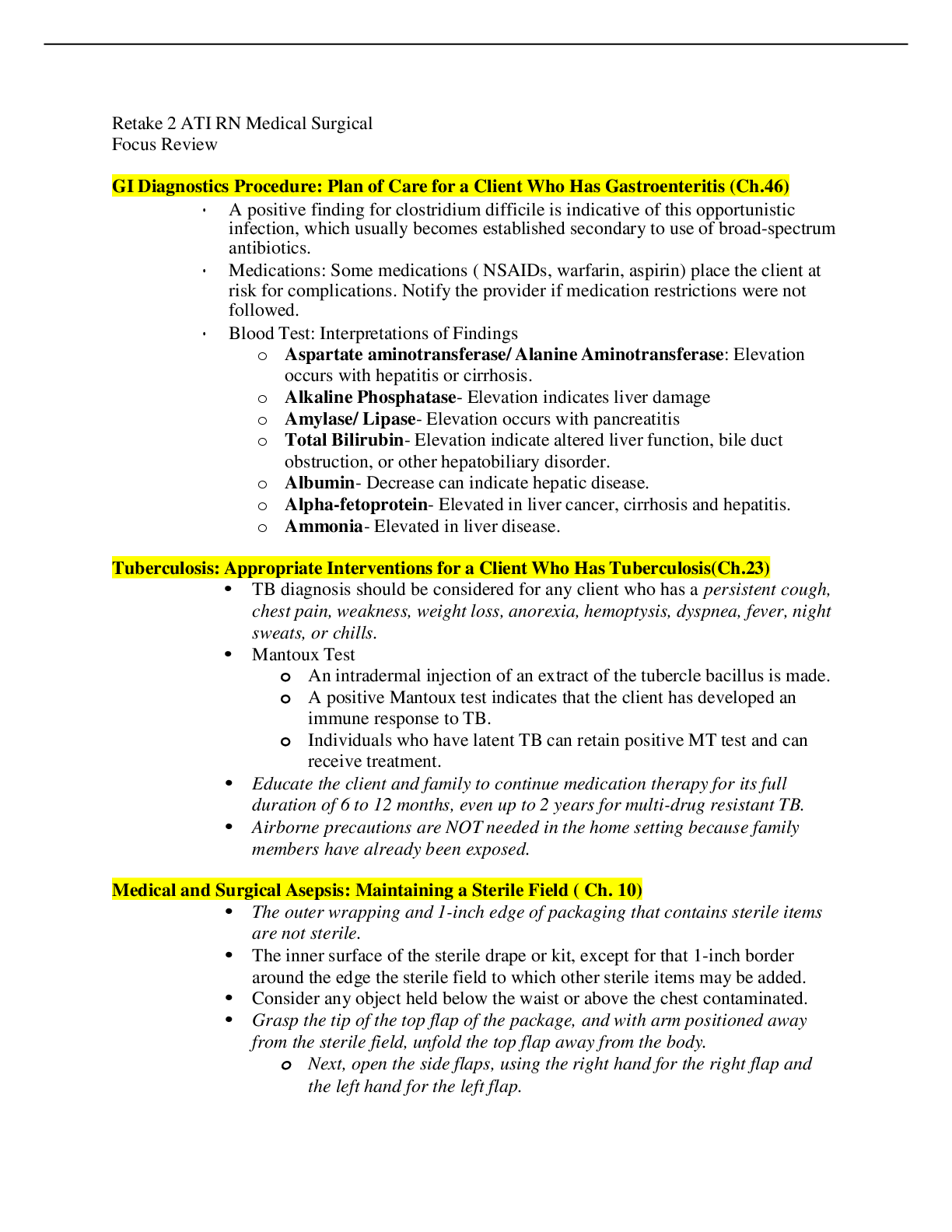
Buy this document to get the full access instantly
Instant Download Access after purchase
Buy NowInstant download
We Accept:

Reviews( 0 )
$10.00
Can't find what you want? Try our AI powered Search
Document information
Connected school, study & course
About the document
Uploaded On
Oct 27, 2021
Number of pages
7
Written in
Additional information
This document has been written for:
Uploaded
Oct 27, 2021
Downloads
0
Views
136








